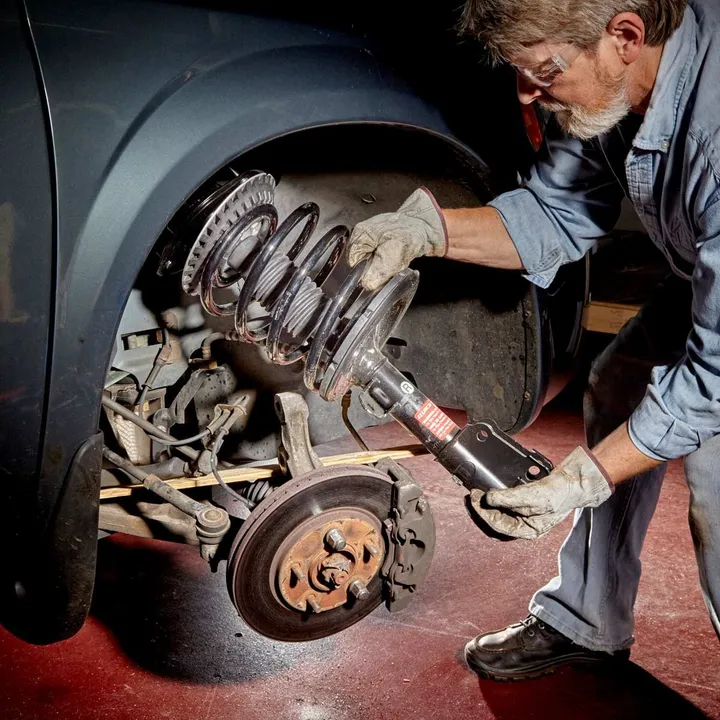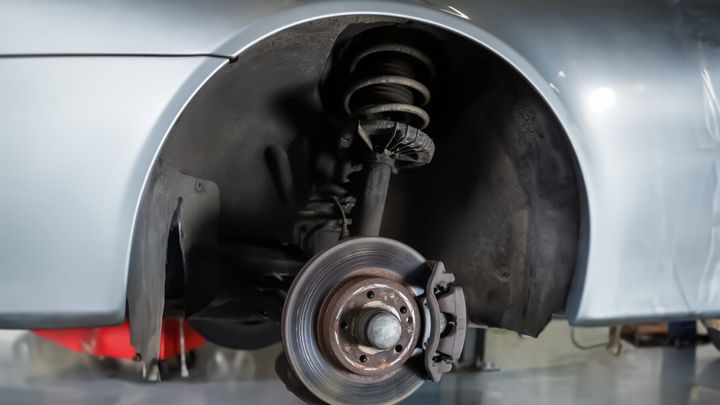


Struts are an integral part of a vehicle's suspension system, responsible for providing a smooth and comfortable ride while ensuring proper handling and stability. However, like any other component, struts can wear out over time due to various factors. Replacing worn-out struts is crucial for maintaining your vehicle's safety and performance. This comprehensive guide delves into the intricacies of strut replacement, exploring the factors that influence the time required, the step-by-step process, cost considerations, and safety precautions. Whether you're a DIY enthusiast or prefer professional assistance, this guide will equip you with the knowledge to make informed decisions about when and how to replace your vehicle's struts.

Recognizing the telltale signs of worn-out struts is the first step in determining the need for replacement. Here are some common indicators:
| Sign | Description |
|---|---|
| Bouncy or Unstable Ride | If your vehicle feels unsettled or bounces excessively after going over bumps or dips, it could be a sign of worn-out struts. |
| Uneven Tire Wear | Faulty struts can cause uneven weight distribution, leading to premature and uneven tire wear. |
| Leaking Fluid | Any fluid leaks around the strut area indicate that the strut seals have failed and need replacement. |
| Noises or Clunking Sounds | Strange noises or clunking sounds coming from the suspension area, especially when going over bumps, can be a symptom of worn struts. |
Neglecting these signs can compromise your vehicle's safety and performance. Regular inspections and addressing issues promptly can prevent further damage and costly repairs down the line.
The time required to replace struts can vary significantly depending on several factors:
Vehicle Make and Model: Different vehicles have varying levels of complexity when it comes to suspension systems, which can affect the replacement time.
Front or Rear Strut Replacement: Replacing front struts is generally more time-consuming than replacing rear struts, as front struts are often integrated with the steering system.
Strut Assembly Type: Replacing a complete strut assembly (including the coil spring and other components) is typically faster than replacing individual struts, as it eliminates the need for spring compression.
Rust or Corrosion: If the bolts or components are heavily corroded or rusted, it can significantly increase the time required for removal and installation.
DIY vs. Professional Mechanic: Experienced mechanics with the right tools and equipment can typically replace struts faster than a DIY enthusiast.
The process of strut replacement can be divided into four main stages:
Gather the necessary tools and supplies, including:
Basic hand tools (wrenches, sockets, pry bars, torque wrench)
Spring compressor (if replacing individual struts)
Penetrating oil
Safety equipment (jack stands, safety glasses, gloves)
Safely lift and support the vehicle according to the manufacturer's recommendations, ensuring it is securely positioned on jack stands.
Disconnect the necessary components to access the struts, such as:
Sway bar links
Brake lines
Tie rods
Remove the bolts securing the struts.
If replacing individual struts, use a spring compressor to safely remove the coil spring.
Install the new strut assembly or individual strut, following the reverse order of removal.
Ensure proper alignment and adhere to the manufacturer's torque specifications.
Reconnect all the disconnected components.
Reinstall the wheels and lower the vehicle.
While the actual time required can vary based on the factors mentioned earlier, here are some average time estimates:
| Replacement Type | DIY | Professional |
|---|---|---|
| Front Strut Replacement (Complete Assembly) | 2-4 hours per side | 1-2 hours per side |
| Rear Strut/Shock Replacement | 1-2 hours per side | 30 minutes to 1 hour per side |
It's important to note that these estimates are rough guidelines, and the actual time may be longer or shorter depending on your specific vehicle and any complications that may arise during the process.
In addition to the time required, it's crucial to consider the cost implications of strut replacement. The primary cost factors include:
A complete strut assembly can cost anywhere from $150 to $500 or more per strut, depending on:
Vehicle make and model
Choice of OEM or aftermarket parts
If you opt for professional mechanic services, labor costs can range from $100 to $300 or more per strut, depending on:
Location
Mechanic's hourly rate
After replacing struts, it's essential to have a professional wheel alignment performed to ensure proper tire wear and handling. Wheel alignments typically cost between $50 and $100.
Strut replacement can be a complex and potentially dangerous task if not performed correctly. Here are some essential safety precautions and tips:

Always follow the manufacturer's recommended procedures and torque specifications to ensure safety and proper installation.
Utilize proper safety equipment, such as:
Jack stands
Safety glasses
Gloves
If working with compressed springs, exercise extreme caution and consider seeking professional assistance if you're not experienced.
After installation, double-check all connections and components to ensure proper fitment and function, reducing the likelihood of future issues.
Strut replacement can affect the vehicle's suspension geometry, leading to improper tire wear and handling issues if not properly aligned. Neglecting to have a professional wheel alignment performed after strut replacement can result in:
Premature tire wear
Potential safety concerns
A proper wheel alignment ensures that the vehicle's suspension components are correctly positioned, optimizing:
Tire wear
Handling characteristics
Ultimately, a wheel alignment extends the lifespan of your tires and suspension system.
To ensure optimal performance and safety, it's recommended to inspect your vehicle's struts periodically and replace them as needed. Most manufacturers recommend replacing struts:
Every 50,000 to 100,000 miles
Sooner if any signs of wear or damage are present
Regular maintenance and timely strut replacement not only enhance your driving experience but also contribute to the overall longevity and reliability of your vehicle's suspension system.
Conclusion
Replacing struts is a crucial aspect of vehicle maintenance that should not be overlooked. By understanding the factors that influence the replacement time, the step-by-step process, cost considerations, and safety precautions, you can make informed decisions about when and how to address this important task. Whether you choose to tackle it as a DIY project or seek professional assistance, prioritizing strut replacement can significantly improve your vehicle's safety, handling, and overall driving experience.
Driving with worn-out struts can lead to poor handling, increased stopping distances, and uneven tire wear. It also puts additional strain on other suspension components, potentially leading to premature failure.
It is generally recommended to replace struts in pairs (both front or both rear) to maintain balanced suspension performance and handling characteristics.
Inspect the strut mounts for signs of wear, such as cracks, tears, or excessive movement. If they appear damaged, it is advisable to replace them along with the struts.
While it is possible to reuse the old coil springs, it is generally recommended to replace them along with the struts to ensure optimal performance and longevity.
Essential tools include basic hand tools (wrenches, sockets, pry bars), a spring compressor (if replacing individual struts), penetrating oil, and safety equipment like jack stands and safety glasses.
It is recommended to have your vehicle's suspension inspected at least once a year or every 12,000 miles, whichever comes first, to identify any potential issues early on.
Yes, you can drive your vehicle immediately after replacing the struts, but it is crucial to have a professional wheel alignment performed to ensure proper tire wear and handling.
For a professional mechanic, the average time for front strut replacement (complete assembly) is 1-2 hours per side, and for rear strut/shock replacement, it's 30 minutes to 1 hour per side.
Yes, strut replacement can affect your vehicle's ride height, especially if you are replacing the struts with a different type or if the coil springs are not replaced as well.
Signs that you need a wheel alignment after strut replacement include uneven tire wear, pulling to one side while driving, or a crooked steering wheel when driving straight.

Sarah isn't your average gearhead. With a double major in Mechanical Engineering and Automotive Technology, she dived straight into the world of car repair. After 15 years of turning wrenches at dealerships and independent shops, Sarah joined MICDOT to share her expertise and passion for making cars run like new. Her in-depth knowledge and knack for explaining complex issues in simple terms make her a valuable asset to our team.













